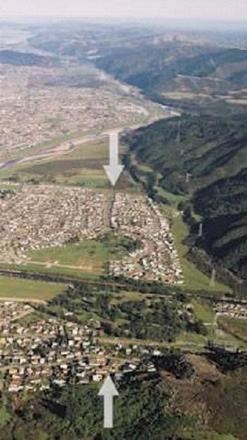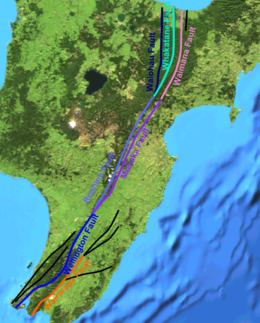Wellington fault
The Wellington Fault is an active seismic fault in the southern part of the North Island of New Zealand. It is a dextral (right-lateral) strike-slip fault with variable amounts of vertical movement causing uplift to the northwest, as expressed by a series of ranges. It forms part of the North Island Fault System, which accommodates the transfer of displacement along the oblique convergent boundary between the Indo-Australian Plate and Pacific Plate.
Contents
- Wellington fault
- Wellington fault fly by
- Geometry
- Wellington Hutt Valley section
- Tararua section
- Pahiatua section
- Seismic hazard
- References

Wellington fault fly by
Geometry
The Wellington Fault consists of three main sections.
Wellington-Hutt Valley section

This 75 km long curved fault segment is mapped on the floor of the Cook Strait before crossing the Wellington peninsula through Long Valley and along the northwestern edge of Wellington Harbour, past Lower Hutt terminating near Kaitoke. This segment has had a lateral slip-rate of 6.0–7.6 mm per year for at least the last 140,000 years, from the progressive offset of dated river terraces. The most recent rupture event along this section is constrained to 150–450 yrs BP. This section is interpreted to give rise to characteristic earthquakes involving rupture of the entire fault segment, with a single-event displacement of 3.8–4.6 m. The recurrence interval is 500–770 years. The Kaitoke basin is a small pull-apart basin formed at the 2 km lateral offset between this segment and the Tararua segment, near Kaitoke.

It is possible that the Māori legend of the formation of Whanganui-a-Tara (Wellington Harbour) derives from an oral record of an early quake along this fault.
Tararua section

The 53 km long arcuate Tararua segment starts just north of Kaitoke along the eastern side of the Tararua Range. It terminates near Putara. It consists of two active fault strands, the southeasterly of which carries most of the displacement, as shown by offset drainage patterns. The strike of this section changes from 041° in the south to 020° in the north. The dextral slip rate for this section is 4.9–7.6 mm/yr, with a single-event displacement of 3.5–5.5 m and a recurrence interval of 500–1120 years.
Pahiatua section

This 42 km long segment runs from near Putara in the south to near Woodville in the north, where the fault branches into the Ruahine and Mohaka Faults. This segment is relatively linear with a strike of 033°. The dextral slip rate for this section is 4.9–6.2 mm/yr, with a single-event displacement of 4.5±1 m and a recurrence interval of 560–1120 years.
Seismic hazard
Although no historic earthquake has been recorded for this fault, the potential impact of rupture along the Wellington-Hutt Valley section on the Wellington area makes it one of the greatest natural hazards in New Zealand. The Wellington Fault is also capable of producing earthquakes of up to magnitude-8.
